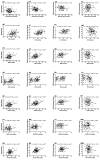Eating Behavior, Physical Activity and Exercise Training: A Randomized Controlled Trial in Young Healthy Adults
- PMID: 33260423
- PMCID: PMC7760390
- DOI: 10.3390/nu12123685
Eating Behavior, Physical Activity and Exercise Training: A Randomized Controlled Trial in Young Healthy Adults
Abstract
Regular physical activity (PA) is an important part of the treatment of several medical conditions, including overweight and obesity, in which there may be a weakened appetite control. Eating behaviour traits influence weight control and may be different in active and sedentary subjects. This paper reports the relationships between the time spent in sedentary behaviour and physical activity (PA) of different intensity, and eating behaviour traits in young, healthy adults. Additionally, it reports the results of a six-month-long, randomized, controlled trial to examine the effect of an exercise intervention on eating behaviour traits. A total of 139 young (22.06 ± 2.26 years) healthy adults (68.35% women) with a Body Mass Index (BMI) of 24.95 ± 4.57 kg/m2 were enrolled. Baseline assessments of habitual PA were made using wrist-worn triaxial accelerometers; eating behaviour traits were examined via the self-reported questionnaires: Binge Eating, Three-Factor Eating Questionnaire-R18 and Control of Eating Questionnaire. The subjects were then randomly assigned to one of three groups: control (usual lifestyle), moderate-intensity exercise (aerobic and resistance training 3¨C4 days/week at a heart rate equivalent to 60% of the heart rate reserve (HRres) for the aerobic component, and at 50% of the 1 repetition maximum (RM) for the resistance component), or vigorous-intensity exercise (the same training but at 80% HRres for half of the aerobic training, and 70% RM for the resistance training). At baseline, sedentary behaviour was inversely associated with binge eating (r = -0.181, p < 0.05) and with uncontrolled eating (r = -0.286, p = 0.001). Moderate PA (MPA) was inversely associated with craving control (r = -0.188, p < 0.05). Moderate-to-vigorous PA (MVPA) was directly associated with binge eating (r = 0.302, p < 0.001) and uncontrolled eating (r = 0.346, p < 0.001), and inversely associated with craving control (r = -0.170, p < 0.015). Overall, PA was directly associated with binge eating (r = 0.275, p = 0.001), uncontrolled eating (r = 0.321, p < 0.001) and emotional eating (r = 0.204, p < 0.05). Additionally, only emotional eating was modified by the intervention, increasing in the vigorous-intensity exercise group (p < 0.05). In summary, we observed that time spent in sedentary behaviour/PA of different intensity is associated with eating behaviour traits, especially binge eating in young adults. In contrast, the six-month exercise intervention did not lead to appreciable changes in eating behaviour traits.
Keywords: accelerometry; appetite; binge eating; energy intake; nutrition.
Conflict of interest statement
The authors declare no conflict of interest.
Figures







References
-
- Blundell J.E. The Control of Appetite: Basic Concepts and Practical Implications. Schweiz. Med. Wochenschr. 1999;129:182–188. - PubMed
Publication types
MeSH terms
Grants and funding
LinkOut - more resources
Full Text Sources
Medical
Miscellaneous

